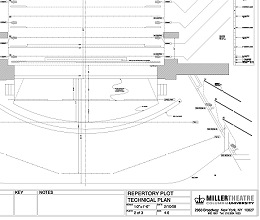 Well, that is if the time happens to be this Tuesday September 08 from 7:00pm EDT, ’till 7:00pm EDT Wednesday September 09, and you pin your ear to Princeton’s WPRB (103.3FM). I’m just reminding you of what Elodie Lauten has already so nicely plugged a little while back on her own blog: that it’s once again time for radio host Marvin Rosen to serve up his annual Classical Discoveries Marathon.
Well, that is if the time happens to be this Tuesday September 08 from 7:00pm EDT, ’till 7:00pm EDT Wednesday September 09, and you pin your ear to Princeton’s WPRB (103.3FM). I’m just reminding you of what Elodie Lauten has already so nicely plugged a little while back on her own blog: that it’s once again time for radio host Marvin Rosen to serve up his annual Classical Discoveries Marathon.
And by “all new”, I don’t mean just the stock & standard 20th-century stuff; this year’s adventure is titled “Viva 21st Century – American Edition” — music by almost 100 composers alive and working in the here and now! It’s safe to say that there’s just about nothing else on the airwaves that can match that achievement, so you’ve got every reason to be there and not be square.
If that’s not enough, on Wednesday September 16th Marvin is hosting an 80th birthday celebration of George Crumb. From 11:00am till 3:00pm Crumb himself will join Marvin, along with Orchestra 2001 conductor James Freeman. And just prior, from 8:30 am until 11am, Marvin’s guest will be composer Derek Bermel.
Tune in and hang on; your crash-course in what’s been happening the last 8.5 years is about to begin! Infinite thanks to Marvin and his commitment to the cause of our new music.
 Tonight’s performance by Charlemagne Palestine was, in short, one of the most extraordinary musical experiences of my life. Palestine has developed a technique for playing the organ which involves the use of wooden shims to hold down keys so he can build up drones with many notes and still have his hands free to improvise melodies over top of it. He starts with an open fifth and builds over the course of a couple hours to a dense roar that uses most of the available power of the instrument. It was mesmerizing. In truth, I wasn’t expecting to like it much — I expected it to be long and loud and somewhat interesting but ultimately boring. I couldn’t have been more wrong, and I urge you that if you ever have an opportunity to hear Palestine play you not miss it for anything.
Tonight’s performance by Charlemagne Palestine was, in short, one of the most extraordinary musical experiences of my life. Palestine has developed a technique for playing the organ which involves the use of wooden shims to hold down keys so he can build up drones with many notes and still have his hands free to improvise melodies over top of it. He starts with an open fifth and builds over the course of a couple hours to a dense roar that uses most of the available power of the instrument. It was mesmerizing. In truth, I wasn’t expecting to like it much — I expected it to be long and loud and somewhat interesting but ultimately boring. I couldn’t have been more wrong, and I urge you that if you ever have an opportunity to hear Palestine play you not miss it for anything. A day that starts at 9AM and ends after 11 at night, in which 15 different people give presentations, and which culminates in a two hour concert, is not a day that is easy to distill down to a single theme (except perhaps happy exhaustion). We began with no fewer than six papers on Steve Reich, some of which were thematically linked but none of which was redundant. Perhaps my favorite moment of those morning sessions was when Sumanth Gopinath compared a feature of Different Trains to the music from a classic 1980s IBM commercial. In the afternoon we had papers on Part, Eastman, Glass, and Young. Kyle Gann described his painstaking reconstruction of Dennis Johnson‘s pivotal-yet-nearly-lost November, which Kyle and Sarah Cahill will be performing in all its 5-hour glory on Sunday. And at the end of the day the great Tom Johnson, who was the Downtown critic for the Village Voice from 1971 to 1982 and who now lives in Paris, gave an hour-long presentation on European minimalist music that we in the United States aren’t familiar with, and on some of his own music. Johnson’s book The Voice of New Music is essential reading for anybody who wants to understand minimalism, and it was a real thrill to hear his current thoughts on the European scene.
A day that starts at 9AM and ends after 11 at night, in which 15 different people give presentations, and which culminates in a two hour concert, is not a day that is easy to distill down to a single theme (except perhaps happy exhaustion). We began with no fewer than six papers on Steve Reich, some of which were thematically linked but none of which was redundant. Perhaps my favorite moment of those morning sessions was when Sumanth Gopinath compared a feature of Different Trains to the music from a classic 1980s IBM commercial. In the afternoon we had papers on Part, Eastman, Glass, and Young. Kyle Gann described his painstaking reconstruction of Dennis Johnson‘s pivotal-yet-nearly-lost November, which Kyle and Sarah Cahill will be performing in all its 5-hour glory on Sunday. And at the end of the day the great Tom Johnson, who was the Downtown critic for the Village Voice from 1971 to 1982 and who now lives in Paris, gave an hour-long presentation on European minimalist music that we in the United States aren’t familiar with, and on some of his own music. Johnson’s book The Voice of New Music is essential reading for anybody who wants to understand minimalism, and it was a real thrill to hear his current thoughts on the European scene.
 Up and running for a few weeks now,
Up and running for a few weeks now, 